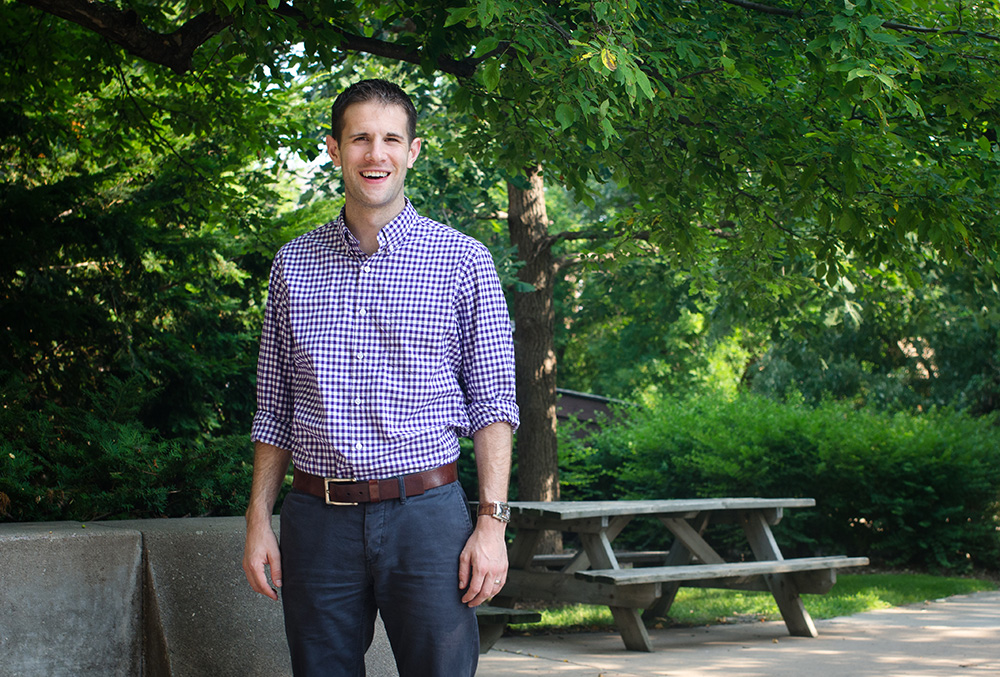What difference do early relationships with parents make in a child’s life? Do people parent their children the way they were parented? How much does nurture or nature shape who people become?
Nearly everyone wonders about these things. Lee Raby is getting the chance to help find out. As a graduate student in the Institute of Child Development, he is part of the research team for the Minnesota Longitudinal Study of Risk and Adaptation.
The study has been following about 200 people, originally born into poverty, from birth into their mid-30s. It began as just a two-year study to see what impact pre-natal and very early parent-child interactions made on infants’ development. Over the years, research expanded to look at the impact of those early interactions on relationships with peers, friends, and romantic partners, too.
“I’m interested in the relationships that the people in the study are now forming with their own kids,” says Raby. “We have the unique opportunity to use the same assessments we used with their moms to understand if adults parent like they were parented and how changes in parenting occur, for better or for worse.”
The research participants are invited periodically to complete assessments related to their current life stage. In the cheerful, comfy old offices of Child Development, they are greeted by the familiar face of a long-time staff member and then talk about their lives with a researcher like Raby.
When the project began nearly forty years ago, environment was thought to be the main factor determining how people developed. With advances in biology, the role of genetics became more apparent.
“Science has come to a consensus now that both are involved—genes and environment—but the question is how do they go together?” Raby says.
Shortly before he arrived, it became possible to collect genetic information. Participants in the study were asked to donate cheek swabs, which were used to extract DNA.
“Fortunately, genotypes don’t change,” Raby explains. “So now I’m reanalyzing old data with the added lens of genetics. We are discovering that nature and nurture are more closely related than we thought. We’re building bridges between two bodies of research to solve a really complex puzzle.”
Raby is thrilled to be part of the process. But growing up in suburban Kansas City, he never dreamed he’d even go to graduate school. His parents worked in the business world; he seemed to be following in their footsteps.
A college internship in St. Louis changed everything. The location was a residential treatment program for children and adolescents with severe behavior problems. In the beginning, Raby admits, he thought they were “just bad kids who needed some structure and discipline.” That summer, he learned two life-changing lessons.
“First, these weren’t bad kids,” he says. “Ninety percent of the time they were fun to be with. It was when they got upset that they were different. They got upset quickly, and when they did, it was explosive. I realized they just seemed to have trouble with this one thing.
“Then I read their case files,” he continues, “and every single one had experienced some kind of relationship trauma: abuse, neglect, bitter divorces, witnessing violence. I thought, ‘This cannot be a coincidence.’ It gave me a lot of empathy. It also made me curious.”
In a psychology course that fall, one entire class was devoted to the impact of early relationship experiences for children’s development. It was all about the Minnesota Longitudinal Study of Risk and Adaptation because it is the best source on the topic.
“I ran to the professor’s office afterward because I had to know more,” Raby says. “I realized there’s a whole branch of science devoted to this. It’s academically interesting but also practically important because we can learn to intervene more effectively with families and even prevent problems.”
For the first time, Raby started thinking about graduate school. In the end, he decided on a Ph.D. program. “Our understanding needs to get better so we can be more effective in the clinical setting,” he says. He extended his undergraduate study by a year, adding research experience and working with children. His hard work paid off when he was accepted at Minnesota.
“This study has been a leader in the field for so long and has provided clues for how to improve individuals’ lives,” says Raby. “It’s an honor to be part of it.”
Learn more about Lee Raby and the Minnesota Longitudinal Study of Risk and Adaptation. Many of the study’s findings are described in The Development of the Person, by Sroufe, Egeland, Carlson, and Collins, 2005.
Story by Gayla Marty | July 2012
